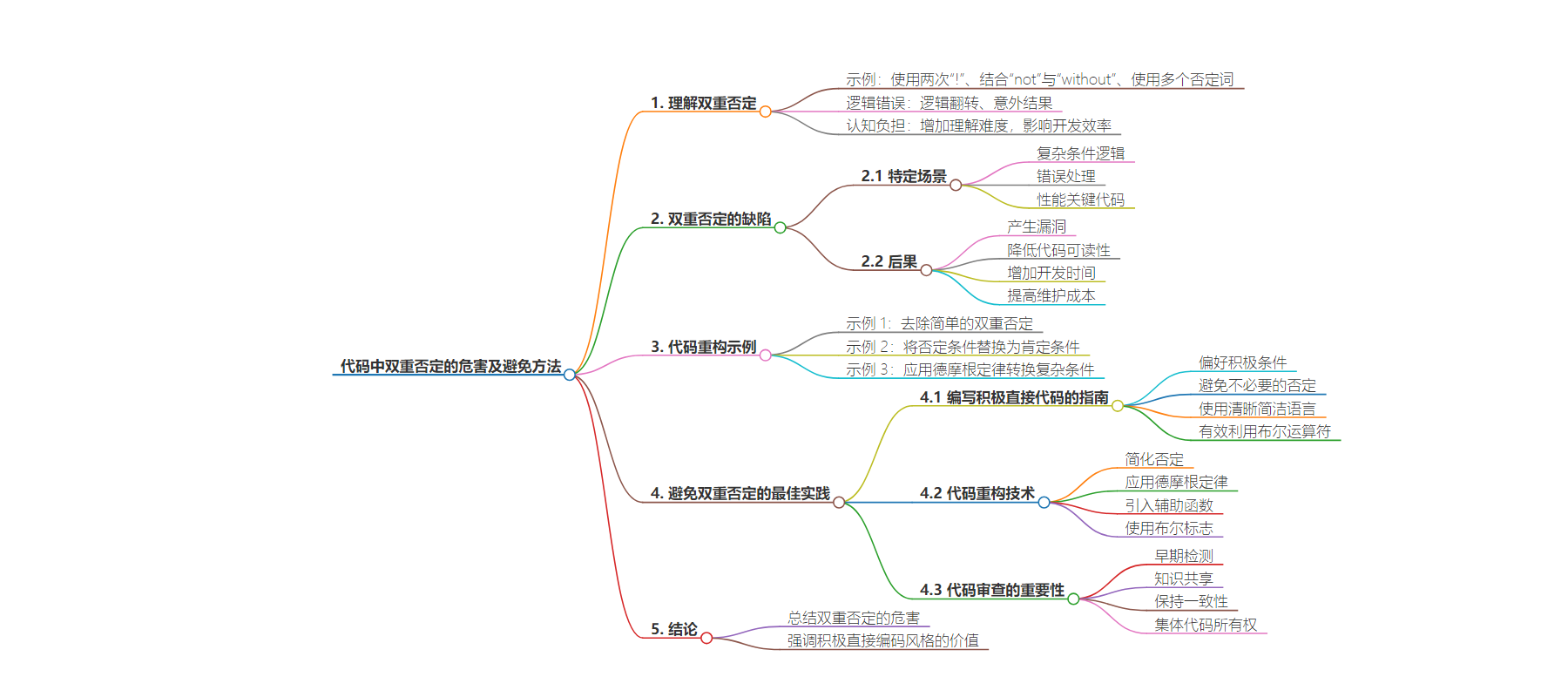包阅导读总结
1. `Double Negatives`、`Code Clarity`、`Logic Errors`、`Code Refactoring`、`Best Practices`
2. 本文主要论述了代码中双重否定的危害,包括造成逻辑混乱、增加认知负担、导致错误等,通过实例介绍了如何避免,如采用积极直接的编码风格和代码重构技术,并强调了代码审查的重要性。
3.
– 双否定对清晰代码的危害
– 理解双否定
– 示例
– 导致逻辑错误
– 增加认知负荷
– 双否定的陷阱
– 特定场景
– 不良后果
– 现实案例
– 代码重构示例
– 多种情况的重构方法及解释
– 避免双否定的最佳实践
– 写作积极直接代码的指南
– 代码重构技术
– 代码审查的重要性
– 结论
– 强调避免双否定以提高代码质量
思维导图:
文章地址:https://www.javacodegeeks.com/2024/08/double-negatives-the-enemy-of-clear-code.html
文章来源:javacodegeeks.com
作者:Eleftheria Drosopoulou
发布时间:2024/8/9 12:26
语言:英文
总字数:923字
预计阅读时间:4分钟
评分:87分
标签:代码可读性,双重否定,Java,代码重构,最佳实践
以下为原文内容
本内容来源于用户推荐转载,旨在分享知识与观点,如有侵权请联系删除 联系邮箱 media@ilingban.com
Code readability is paramount for maintainable and efficient software development. While the logic behind code might be crystal clear to the developer, it’s essential to consider the perspective of others who might need to understand, modify, or debug it. One common culprit of unclear code is the insidious use of double negatives.
Just as in plain language, double negatives in code can create confusion and hinder comprehension. By avoiding them, you can significantly enhance code clarity, reduce the potential for errors, and improve overall code quality. Let’s delve into the world of double negatives and explore why they should be banished from your codebase.
1. Understanding Double Negatives
Examples of Double Negatives
A double negative in code happens when you use two ways of saying “not” together. This makes the code harder to understand.
Here are some examples:
- Using
!twice:if (!(!condition)) - Combining
notwithwithout:if not without errors - Using negative words together:
if item is not empty
Logical Errors from Double Negatives
Double negatives can lead to mistakes in your code’s logic. This is because they make it difficult to figure out what the code is actually doing. For example:
- Flipped logic:
if (!(!condition))is the same asif (condition), but it’s confusing to read. - Unexpected results: Using
not withoutmight not mean what you think. It can cause your code to do the opposite of what you want.
Cognitive Load
Double negatives make your brain work harder to understand the code. This is called “cognitive load”. When code is hard to understand, it takes longer to fix bugs or add new features.
To make your code easier to read and understand, it’s best to avoid double negatives.
2. The Pitfalls of Double Negatives
Specific Scenarios
Double negatives are particularly harmful in these situations:
- Complex conditional logic: When multiple conditions are combined using
notor other negative operators, the logic can become convoluted and difficult to follow. - Error handling: Negative conditions for error handling can obscure the intended behavior, making it harder to identify and fix issues.
- Performance-critical code: Extra negations can sometimes introduce unnecessary calculations or comparisons, impacting performance.
Consequences of Double Negatives
Using double negatives can lead to:
- Bugs: Misunderstanding the logic due to double negatives can result in incorrect behavior, leading to bugs that are hard to find and fix.
- Reduced code readability: Double negatives make code harder to understand, increasing the time it takes to maintain and modify.
- Increased development time: Developers spend more time deciphering code with double negatives, slowing down development.
- Higher maintenance costs: Code with double negatives is more prone to errors, leading to higher maintenance costs.
Real-World Examples
Consider these examples:
- Incorrect error handling:
if (!(!error)) { // Handle error}
This code is equivalent to if (error), but the double negation makes it harder to understand the intent.
- Complex conditional logic:
if not (not condition1 and not condition2): # Do something
This can be simplified to if (condition1 or condition2):
- Performance impact: While not always significant, unnecessary negations can sometimes impact performance, especially in tight loops.
3. Code Refactoring Examples
Let’s see how to transform code with double negatives into clearer alternatives.
Example 1: Double Negation
if not (not is_valid): # Do something
Refactored:
if is_valid: # Do something
Example 2: Negative Conditionals
if (!isEmpty(list)) { // Process the list}
Refactored:
if (list.length > 0) { // Process the list}
Example 3: Combined Negatives
if (!(x < 5 && y > 10)) { // Do something}
Refactored:
if (x >= 5 || y <= 10) { // Do something}
Explanation:
- The first example demonstrates the simplest form of double negation, which can be easily removed.
- The second example shows how to replace a negative condition with a positive one based on the specific context.
- The third example involves De Morgan’s law to transform a complex condition with multiple negations into a more readable form.
4. Best Practices for Avoiding Double Negatives
4.1 Guidelines for Writing Positive and Direct Code
- Prefer positive conditions: Whenever possible, express conditions positively. For example, instead of
if not is_empty, useif is_not_empty. - Avoid unnecessary negations: Eliminate redundant
notoperators. - Use clear and concise language: Choose words and operators that accurately convey your intent without introducing ambiguity.
- Leverage boolean operators effectively: Understand the difference between
and,or, andnotto construct clear logical expressions.
4.2 Code Refactoring Techniques
- Simplify negations: Break down complex negated expressions into simpler components.
- Apply De Morgan’s law: Use De Morgan’s law to transform negated conjunctions and disjunctions.
- Introduce helper functions: Create functions to encapsulate complex logic, making it easier to reason about.
- Use boolean flags: Employ boolean flags to represent conditions in a more readable manner.
4.3 The Importance of Code Reviews
- Early detection: Code reviews help identify double negatives early in the development process, preventing them from becoming entrenched.
- Knowledge sharing: Reviewers can offer alternative approaches and suggest improvements.
- Consistency: Code reviews promote consistent coding style and adherence to best practices.
- Collective code ownership: By involving multiple developers in the review process, a shared sense of responsibility for code quality is fostered.
5. Conclusion
Double negatives are the silent saboteurs of code clarity. By understanding their detrimental impact on readability, logic, and maintainability, developers can take significant strides towards writing cleaner, more efficient code.
We’ve explored how double negatives can obscure meaning, introduce errors, and hinder collaboration. Through concrete examples and practical refactoring techniques, we’ve demonstrated the value of adopting a positive and direct coding style.
